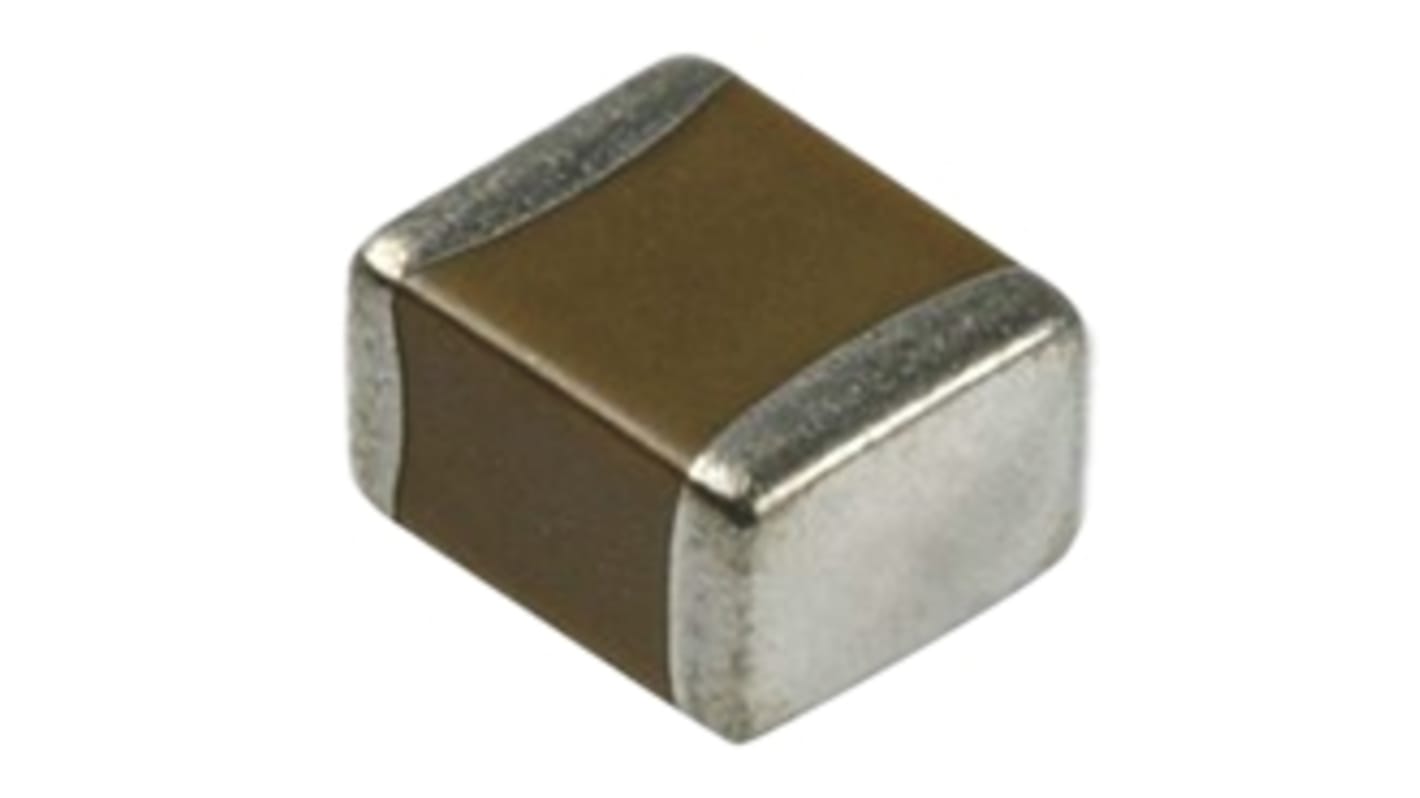Murata 2.2pF Multilayer Ceramic Capacitor MLCC, 50V dc V, ±0.25pF , SMD
- RS Stock No.:
- 820-2724
- Mfr. Part No.:
- GRM0335C1H2R2CA01D
- Brand:
- Murata

Bulk discount available
Subtotal (1 reel of 500 units)*
£2.00
(exc. VAT)
£2.50
(inc. VAT)
FREE delivery for orders over £50.00
In Stock
- 11,500 unit(s) ready to ship
Need more? Click ‘Check delivery dates’ to find extra stock and lead times.
Units | Per unit | Per Reel* |
|---|---|---|
| 500 - 4500 | £0.004 | £2.00 |
| 5000 + | £0.004 | £2.00 |
*price indicative
- RS Stock No.:
- 820-2724
- Mfr. Part No.:
- GRM0335C1H2R2CA01D
- Brand:
- Murata
Specifications
Technical Reference
Legislation and Compliance
Product Details
Find similar products by selecting one or more attributes.
Select all | Attribute | Value |
|---|---|---|
| Brand | Murata | |
| Capacitance | 2.2pF | |
| Voltage | 50V dc | |
| Package/Case | 0201 (0603M) | |
| Mounting Type | Surface Mount | |
| Dielectric | C0G | |
| Tolerance | ±0.25pF | |
| Dimensions | 0.6 x 0.3 x 0.3mm | |
| Length | 0.6mm | |
| Depth | 0.3mm | |
| Height | 0.3mm | |
| Series | GRM | |
| Minimum Operating Temperature | -55°C | |
| Maximum Operating Temperature | +125°C | |
| Terminal Type | Surface Mount | |
| Select all | ||
|---|---|---|
Brand Murata | ||
Capacitance 2.2pF | ||
Voltage 50V dc | ||
Package/Case 0201 (0603M) | ||
Mounting Type Surface Mount | ||
Dielectric C0G | ||
Tolerance ±0.25pF | ||
Dimensions 0.6 x 0.3 x 0.3mm | ||
Length 0.6mm | ||
Depth 0.3mm | ||
Height 0.3mm | ||
Series GRM | ||
Minimum Operating Temperature -55°C | ||
Maximum Operating Temperature +125°C | ||
Terminal Type Surface Mount | ||
Murata GRM 0201 C0G/X5R/X7R Dielectric
Murata GRM Series high dielectric constant type are small in size and large capacitance values in a multi-layer structure
High reliability with no polarity
Excellent solderability is achieved by the Tin plating at the external electrodes
Applications in decoupling and smoothing circuits
High reliability with no polarity
Excellent solderability is achieved by the Tin plating at the external electrodes
Applications in decoupling and smoothing circuits
GRM Series Temperature Compensating type are ideal for tuning circuits, oscillating circuits,high frequency filter circuits and power supply damper snubber for rated voltages higher than 200V
0201 Range
Nickel barrier terminations covered with a layer of plated Tin (NiSn)
Applications include mobile phones, video and tuner designs
C0G/NP0 is the most popular formulation of the "temperature compensating", EIA Class I ceramic materials
X7R, X5R formulations are called "temperature stable" ceramics and fall into the EIA Class II materials
Y5V, Z5U formulations are for general purpose use in a limited temperature range, EIA Class II materials; these characteristics are ideal for decoupling applications.
Applications include mobile phones, video and tuner designs
C0G/NP0 is the most popular formulation of the "temperature compensating", EIA Class I ceramic materials
X7R, X5R formulations are called "temperature stable" ceramics and fall into the EIA Class II materials
Y5V, Z5U formulations are for general purpose use in a limited temperature range, EIA Class II materials; these characteristics are ideal for decoupling applications.
Related links
- Murata 2.2pF Multilayer Ceramic Capacitor MLCC ±0.25pF , SMD
- KEMET 2.2pF Multilayer Ceramic Capacitor MLCC ±0.25pF , SMD
- TDK 2.2pF Multilayer Ceramic Capacitor MLCC ±0.25pF , SMD
- Murata 2.2pF Multilayer Ceramic Capacitor MLCC ±0.1pF , SMD
- Yageo 2.2pF MLCC ±0.25pF , SMD
- KEMET 2.2pF Multilayer Ceramic Capacitor MLCC ±0.25pF , SMD
- KEMET 2.2pF Multilayer Ceramic Capacitor MLCC ±0.25pF , SMD
- KEMET 2.2pF Multilayer Ceramic Capacitor MLCC ±0.25pF , SMD
